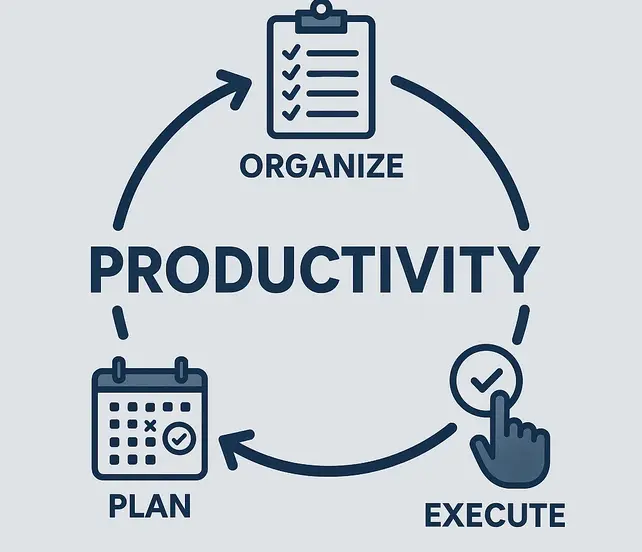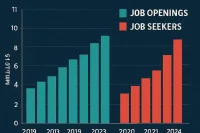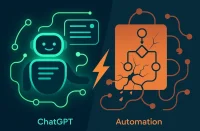Stop wasting time with ineffective productivity methods and discover a simple system that actually works. This isn’t about doing more stuff or working longer hours—it’s about making every work session count through focused, time-based deep work. After years of experimenting with complex apps and productivity hacks, I’ve developed a straightforward system that multiplies what I can accomplish in the same amount of time, and it all starts with something so simple you might laugh: a physical timer.
The key to true productivity isn’t about fancy mobile apps or working longer hours. It’s about implementing a few simple habits that make every work session more focused and effective. This system is based on Cal Newport’s research on deep work, which identifies two core abilities for thriving in the new economy: the ability to quickly master hard things and the ability to produce at an elite level in terms of both quality and speed.
Table of Contents
The Power of a Physical Timer
Stop wasting time on complex digital solutions when a simple physical timer can transform your productivity. This little device—which looks like a kids’ toy—has been the single most powerful addition to my workflow this year. You simply spin the dial around, it counts down, and buzzes when time’s up. No apps, no notifications, no distractions.
The beauty of this approach lies in its simplicity. Often the best solutions come from effective use of simple things rather than ineffective use of complex things. I’ve tried all the phone apps, but they’re not just timer apps—they’re part of a complex distraction machine that never sleeps. This physical timer, on the other hand, is simple, does the job well, and alerts only once when it’s over.
The real power comes from understanding the enemy of productivity: context switching. This is the process of rapidly changing focus between different tasks, projects, or contexts, which reduces cognitive capacity and productivity while causing stress and mental exhaustion. Every time you switch contexts, you lose time and mental energy reloading information and recreating focus.
Focus on What Matters
Productivity isn’t about complexity—it’s about clarity and focus. Employers can maximize team output by hiring professionals who know how to manage time effectively and avoid the trap of context switching. Post your job on WhatJobs today and connect with talent that brings discipline, focus, and results to every project.
Post a Job Free for 30 Days →The Deep Work Method
Stop wasting time on fragmented work sessions and embrace focused, time-based deep work. Here’s how the system works: when you have a task to work on, estimate how long it will take (never more than an hour), set the timer, put your phone on do not disturb, put on instrumental focus music, and don’t stop until the timer buzzes.
The key principles are:
- Never work more than one hour continuously
- Enter a zone and don’t leave it until the timer alerts you
- Always feel energized coming out of these sessions
- Use the completed work as a morale boost throughout the day
This method eliminates context switching and allows you to enter a state of deep focus where you can accomplish significantly more in less time. The timer creates a psychological boundary that helps you commit fully to the task at hand.
The Walking Break System
Stop wasting time by jumping from one task to another without proper decompression. After each deep work session, take a walk. This simple practice allows you to decompress from the focus session, gets your blood flowing again, and is essential for maintaining energy throughout the day.
Historical figures have long recognized the power of walking. Søren Kierkegaard said, “I have walked myself into my best thoughts, and I know of no thought so burdensome that one cannot walk away from it.” Charles Lamb noted, “I always arrive late at the office, but I make up for it by leaving early and taking a long walk, which makes me infinitely more fit to work again.”
There’s something about taking a brisk walk that can do wonders for resetting your thoughts, solving problems, and taking the mental load off. If you work from home, this is especially important because being surrounded by the same environment day after day can limit your creativity and ability to formulate new ideas.
Daily Scheduling: The Foundation
Stop wasting time by winging your day and instead spend the first 15 minutes scheduling your focus sessions. This morning routine determines your productivity for the entire day. Block out 15 minutes every morning (I use 8:45 to 9:00 AM) as a recurring calendar slot for planning.
Here’s how to structure your day:
- Look at your available time slots around meetings and other commitments
- Identify your main tasks for the day
- Schedule focus sessions in available time blocks
- Never schedule more than one hour of continuous work
- Always include a walking break after each session
- Break longer tasks into multiple one-hour sessions
For example, if you have three tasks—writing a SQL query, documenting a feature, and creating Terraform configuration—you would schedule them in one-hour blocks with walking breaks in between. This ensures you maintain focus and energy throughout the day.
Calendar Integration for Accountability
Stop wasting time by keeping your focus sessions vague. Add specific tasks directly to your work calendar instead of generic “focus time” blocks. This approach serves multiple purposes:
- It helps you feel more organized and committed to specific tasks
- It keeps you on track about what you’re supposed to do at any given time
- It allows you to look back at the end of each week and see what you’ve achieved
- It shows others exactly what you’re working on, demonstrating your productivity
Instead of “Focus Time,” your calendar might show “Working on SQL Script” or “Writing Documentation.” This level of specificity creates accountability and helps you stay committed to your planned tasks.
Managing Email and Communication
Stop wasting time by constantly checking emails and messages throughout the day. Schedule specific times to handle communication, just like you schedule focus sessions. Your higher-ups want results, not constant availability. If you’re producing great work and delivering consistently, that trumps how responsive you are to every message.
Set boundaries around communication:
- Schedule specific times to check and respond to emails
- Use do not disturb during focus sessions
- Let non-urgent messages wait for your scheduled communication time
- Focus on results rather than responsiveness
Remember, managers and tech leads don’t drop everything to respond to emails immediately—neither should you. Let your work speak for itself and demonstrate the value of your focused work sessions.
Building Your Focus Muscle
Stop wasting time by accepting that you can’t focus for long periods. Focus is a muscle that needs to be strengthened, especially in our distraction-filled world. Constant social media, unchecked AI use, and other digital distractions are eroding our ability to concentrate deeply.
To build your focus muscle:
- Start with shorter sessions and gradually increase the duration
- Remove distractions during focus time
- Practice the timer method consistently
- Be patient with yourself as you develop this skill
The ability to focus for extended periods is becoming increasingly rare and valuable. By developing this skill, you’re not just improving your productivity—you’re building a competitive advantage in the modern workplace.
Hire Talent with the Focus Advantage
Focus is a muscle—and those who master it gain a powerful edge in today’s distraction-heavy world. Employers can unlock higher productivity and creativity by hiring professionals who bring deep concentration and discipline to their work. Post your job on WhatJobs today and connect with candidates who turn focus into a competitive advantage.
Post a Job Free for 30 Days →The Complete Daily Structure
Stop wasting time by implementing this complete system throughout your day. The magic happens when you structure your entire day around these focus sessions:
- Morning Planning (15 minutes): Schedule your focus sessions for the day
- Focus Session (45-60 minutes): Deep work with timer
- Walking Break (10-15 minutes): Decompress and reset
- Repeat throughout the day around meetings and other commitments
This creates a rhythm of focused work followed by movement and decompression, which maintains energy and prevents burnout. Even if you can only fit in one focus session per day, that’s still more productive than fragmented work throughout the day.
Overcoming Common Challenges
Stop wasting time by addressing the most common obstacles to implementing this system. The two biggest concerns are usually about email management and the ability to focus for extended periods.
For email management, the solution is simple: schedule it. Just like you schedule focus sessions, schedule specific times to check and respond to emails. This creates boundaries and ensures you’re not constantly switching contexts.
For focus challenges, remember that this is a skill that can be developed. Start with shorter sessions and gradually build up. The key is consistency and removing distractions during your focus time.
The Long-Term Benefits
Stop wasting time by recognizing that this system provides benefits beyond just increased productivity. When you implement this approach consistently, you’ll experience:
- Higher quality work output
- Increased job satisfaction
- Better work-life balance
- Reduced stress and mental exhaustion
- Greater sense of accomplishment
- Improved focus and concentration skills
The system creates a sustainable approach to work that prevents burnout while maximizing productivity. You’ll find that you accomplish more in less time while feeling more energized throughout the day.
Frequently Asked Questions
How do I start implementing this productivity system?
Stop wasting time by trying to implement everything at once. Start with just the timer method for one focus session per day. Once you’re comfortable with that, add the walking breaks and daily scheduling. Build the system gradually to ensure long-term success.
What if I can’t focus for a full hour?
Stop wasting time by accepting limitations without trying to improve them. Focus is a muscle that can be strengthened. Start with 25-30 minute sessions and gradually increase the duration. Remove distractions and practice consistently to build your focus capacity.
How do I handle urgent requests during focus sessions?
Stop wasting time by constantly switching contexts for non-urgent requests. Set clear boundaries about what constitutes a true emergency. Most requests can wait until your scheduled communication time. Train your team to respect your focus sessions.
Can this system work in a busy office environment?
Stop wasting time by assuming this system only works in ideal conditions. The key is adaptation. Use headphones, find quiet spaces, and communicate your focus schedule to colleagues. Even in busy environments, you can find ways to implement focused work sessions.
A Real-World Example: Sarah’s Productivity Transformation
Sarah Chen, a 28-year-old software developer from Seattle, exemplifies how stop wasting time with this system can transform your work life. After struggling with constant interruptions and fragmented work sessions, Sarah implemented the timer method and daily scheduling.
“I was constantly switching between tasks and never felt like I was making real progress,” Sarah explains. “The physical timer was a game-changer. It forced me to focus on one thing at a time, and I was amazed at how much more I could accomplish in just 45 minutes of focused work.”
Sarah started with 30-minute focus sessions and gradually increased to 60 minutes. “The walking breaks were crucial,” she says. “I work from home, so I would walk around my neighborhood between sessions. It cleared my mind and gave me energy for the next focus block.”
Within two months, Sarah was completing her daily tasks by 3 PM instead of working until 6 PM. “I had more time for personal projects and felt less stressed. The system didn’t just make me more productive—it gave me my life back.”
Sarah’s story demonstrates that this system works in real-world conditions and can transform not just your productivity, but your overall work experience and life satisfaction.
Stop wasting time with ineffective productivity methods and implement this simple system that actually works. The combination of focused work sessions, walking breaks, and daily scheduling creates a sustainable approach to productivity that will transform how you work and live. Start with one focus session per day and build from there—your future self will thank you.




